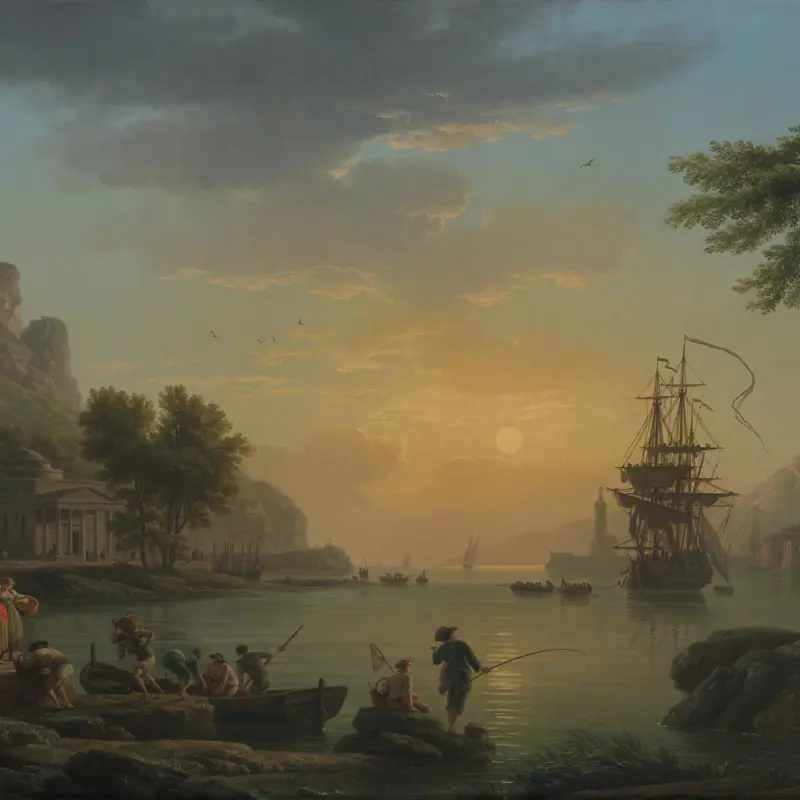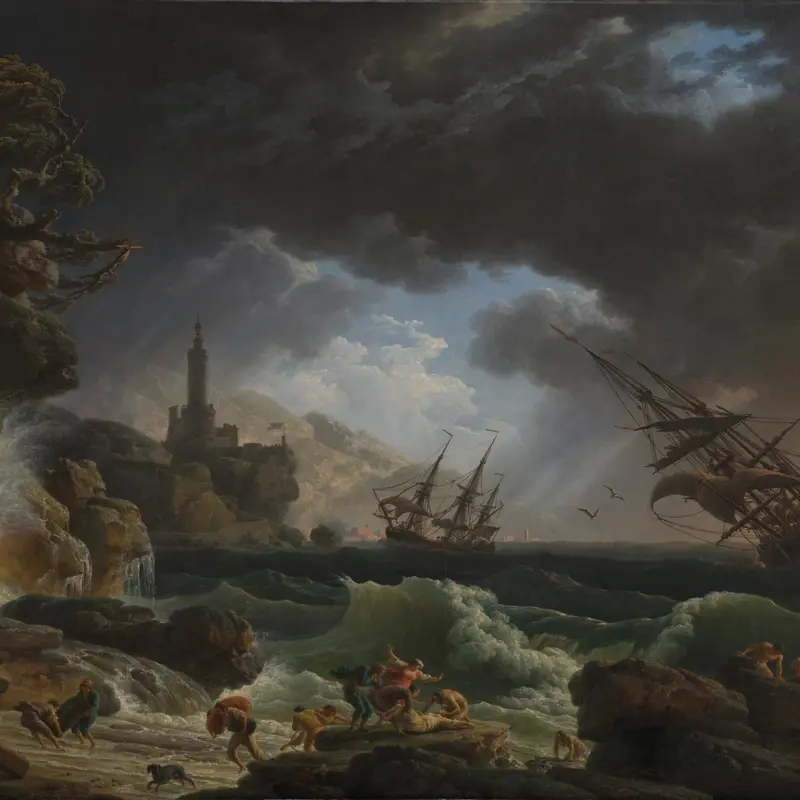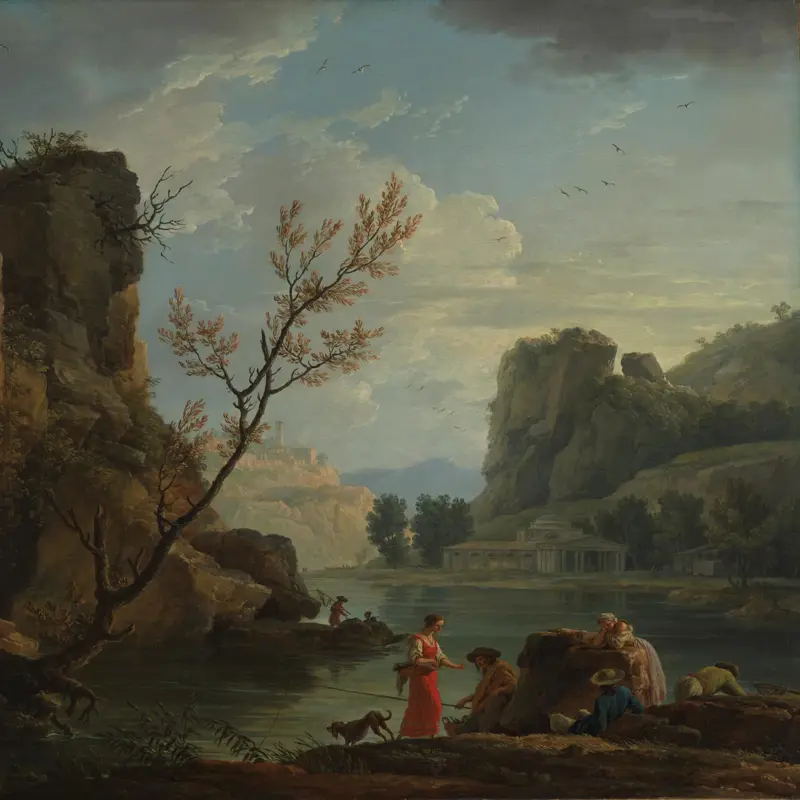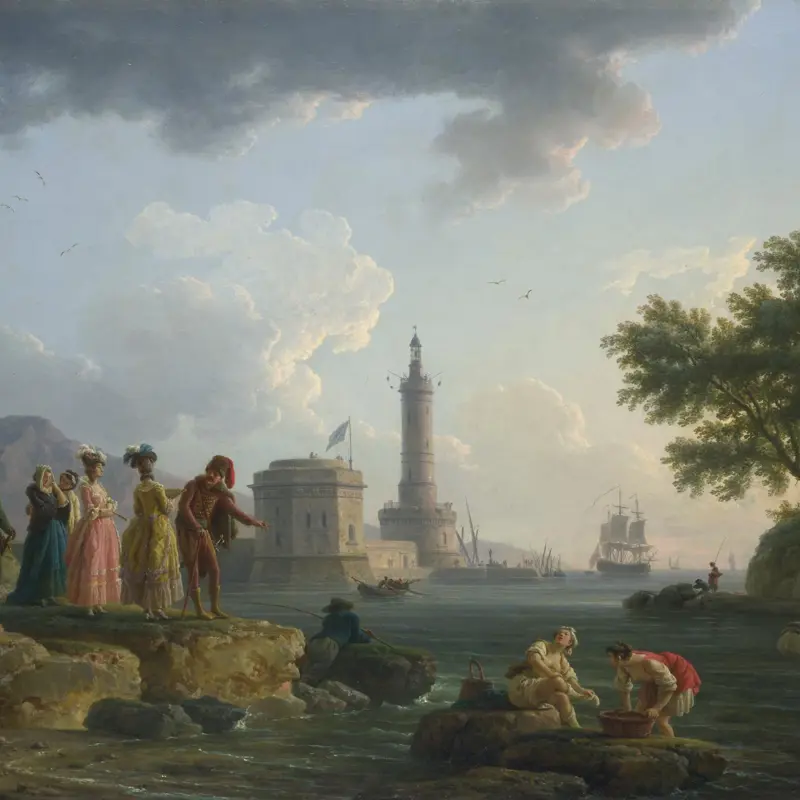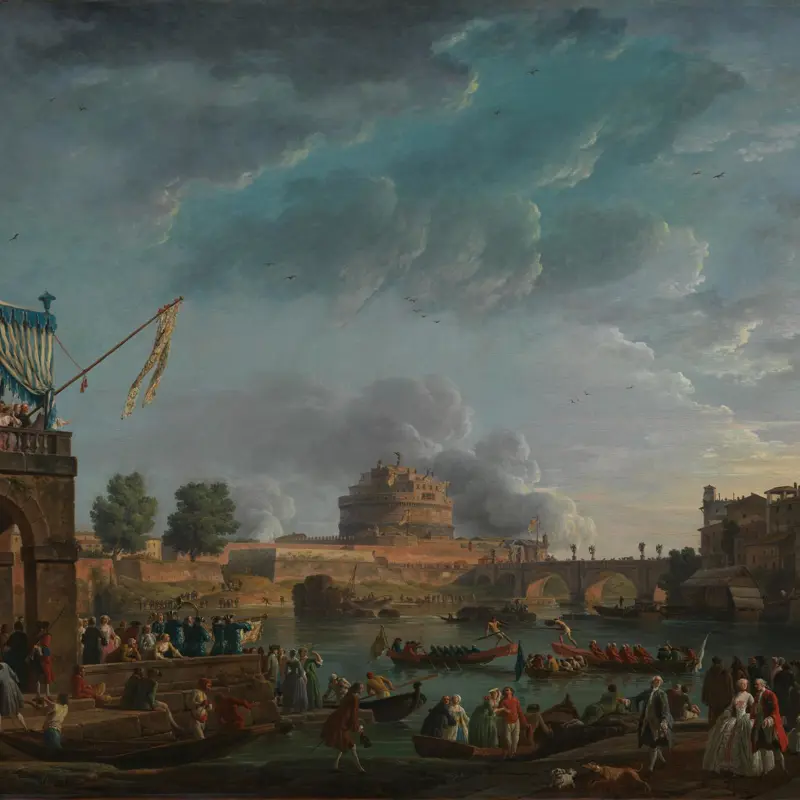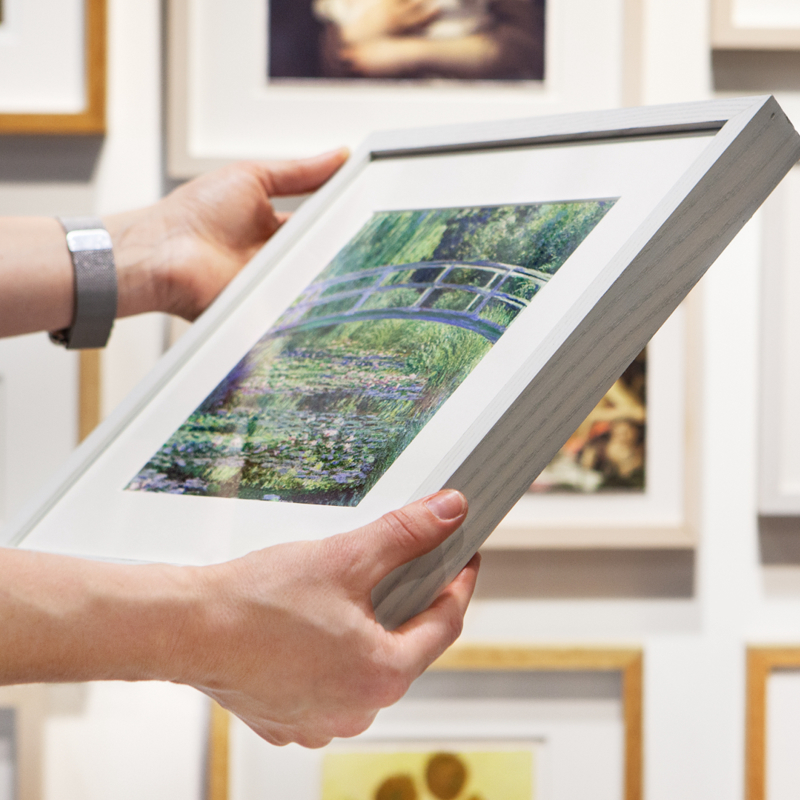Claude-Joseph Vernet, 'A Shipwreck in Stormy Seas', 1773
About the work
Overview
This is one of a pair of seascapes, originally commissioned on behalf of the King of Poland, that the British officer and East India Company official Lord Clive (known as Clive of India) bought from Vernet in 1773.
Originally known as ‘Tempête’ (Storm), it depicts a rocky shoreline buffeted by a violent sea storm. Two ships roll in the giant swell, sails tied down or tattered by the turbulent winds and lashing rain, while a third ship lies shattered against the rocks. Figures carry salvaged goods up the shore, while an unconscious woman is laid out on a rock, her friends overwhelmed with despair.
The extreme, turbulent elements depicted here contrast with the tranquil atmosphere of its pair, ‘Calme’, reflecting ideas fashionable at the time about the beautiful and sublime in nature and art. They are the only great pair of marine views by Vernet in a British public collection.
Audio description
An audio description of Vernet's ‘A Shipwreck in Stormy Seas’
Transcript
This is an audio description for the painting ‘A Shipwreck in Stormy Seas’ by the French artist Claude-Joseph Vernet. It will take 9 minutes to listen to and includes information about the scene depicted and the historical background in which the work was made.
This large rectangular painting is 164 cm wide by 115 cm tall, about a foot shorter than a standard single bed. It is of a dramatic seascape, painted on canvas, using oil paints. The painting is highly detailed, depicting the perilous impacts of a raging storm on some tall ships.
The painting was made as one a one of a contrasting pair. It’s partner ‘Calme’ (now known as ‘A Landscape at Sunset’) depicts a beautiful harbour on a tranquil summer evening as fishermen return with their catch.
They were painted in 1773, when Vernet was nearly 60 years old and able to attract affluent and powerful collectors. He had worked in Rome for many years, building a reputation as a painter of seaports and storms, but returned to his homeland to paint the ports of France for the King - Louis XV.
Both pictures show imaginary scenes, but they are painted with such fine precision and attention to detail that they have a photographic quality about them. Vernet’s works were often praised for their sense of realism, though they are in fact heavily dramatized.
Originally called ‘Tempête’ (or Storm in French), this painting depicts two tall sailing ships at sea along a rocky coast in a violent sea-storm. The survivors of another vessel, broken on craggy rocks in the foreground, are scattered along the shoreline across the bottom of the painting.
It is a dark and dramatic picture. The small figures are dwarfed by the vast scale of the surrounding cliffs and the ominous sea which threatens to pound their ships into submission. The ships reel and lurch in peril in the titanic sea swells as powerful waves slam up against the ragged rocks. Combined with a wild electrical storm, illuminating the top right of the sky with a shock of orange, the scene fills us with a sense of awe and dread. A perfect example of what the writer Edmund Burke defined as ‘sublime’ nature, before which we feel small and perhaps afraid and humbled too.
Vernet makes clever use of slanting diagonal lines in the composition. Formed by the masts of the lurching ships and the double zig-zags of lightning bolts, they throw our sense of balance off of kilter and evoke a sense of instability and unease. A dark and broody colour palate of greys and browns adds to the sinister environment.
A moody sky, dominated by lead-grey storm clouds, and punctuated by the cracks of two lightning bolts, envelops the top two-thirds of the painting.
The bottom third is covered by a slate grey sea, animated by huge swells of waves which rise in rows. Their crests, over a metre high, are tinged with orange light reflected from the lightening in the sky beyond.
One gigantic wave closest to shore curves over into a barrel as it crests. Light filters through its turquoise top as its froth fills a sandy cove in the bottom left foreground.
These waves break against the craggy cliffs of a rocky landscape which curves in a wide bay to the far-left edge of the painting stretching back a mile across into the distance.
Several rocky promontories reach out into the sea, hemmed in by huge cliffs which form a series of smaller bays and inlets, breaking up the larger bay into smaller sections.
Our viewpoint is from a large rocky plateau in the front foreground of the painting looking out across the wider bay. The terrain appears less hazardous the further away we travel.
Working from the land furthest away from us at the top of the picture, down the left side of the painting to the rocky plateau along the bottom edge, we first discover in the far distance a sunlit, mountainous headland sloping down to meet the sea at the horizon line. The tiny shapes of terracotta buildings, suggesting a town or city, are nestled at its base. Light streams down upon it from a break in the centre of the clouds above, revealing hopeful blue sky beyond.
We suspect this bay would provide much calmer seas - a safe harbour, towards which one of the ships attempts to head, but we cannot know for sure. The bay is obscured by a cylindrical lighthouse upon a large rocky outcrop, which juts out into the sea in the middle distance.
Following the land closer to us we find a craggy cliffside rising almost to the full height of the canvas on the left-hand side. Here great waves batter the base of the rocks, pouring like waterfalls back down from the cliffs. Its rocky overhang shelters a sandy cove where large stacks of brown boulders, taller than a man, run along the foreground, separating us from the sea. They provide a place of refuge for the sailors who have survived the shipwreck, and act as a stage set for the human drama.
Three ships have so far survived the storm. One – a three- masted vessel riding a wave on the horizon line, heads in the direction of the lighthouse and calmer bay in the distance. A single row of round gunports for canons tell us that this ship is armed, but the short pennants flying at the top of the masts suggest these are armed merchant ships, not war ships.
This ship also flies a large ragged British red ensign at its bow. The pair of paintings were purchased for a controversial Englishman – Robert Clive, also known as Clive of India who notoriously helped to establish the East India Company’s military and political power through force, ultimately laying the foundation for the British occupation of India.
The direction of the flags tell us the wind is raging in towards land, across the seas from the right. All but one of the cream sails are tied up to the masts. One small sail unfurled at the front mimics the double curve of a seagull’s wings in flight. The ship tilts over 25 degrees to the right of the painting.
A second, larger, closer ship mirrors the first, but appears in greater peril, leaning to the left at a much steeper angle of 45 degrees. It is double decked, with the gun ports of the lower decks closed, to keep out the heavy seas. One of its wind-ripped top-sails flies in tatters from the mast as it struggles to head out away from the wrecking waves near the shore.
Above this ship the gap in the storm clouds glows orange, as two zig-zag lightening- bolts crash down to the horizon where we can just make out the hint of a ship sailing far out in the distance.
In the space between the two merchant ships two seabirds whirl, their curved wings coping much better with the wild winds than the ships’ sails.
At the bottom right corner of the painting we notice the broken remnants of a wooden balustrade and timbers belonging to a tragically wrecked fourth vessel poking out from behind the tallest rock in the foreground. This ship once held at least 13 sailors, who now attempt to drag themselves, and any belongings that they can salvage, from the storm-tossed sea to the safety of land.
Arranged in a line like a frieze along the foreground, these survivors are very small in comparison to their surroundings, serving to increase our sense of awe at the vastness of the terrifying scene.
Some men have made it to the sandy beach in the bottom left corner. Two rescue a large wooden trunk between them. Another lugs a heavy red object over his right shoulder and carries a smaller chest, or barrel, under his left arm while a black dog runs in front of him through the surf. Two more men to the right of him pull strenuously on a rope, attempting to drag a fellow survivor with bedraggled hair onto shore. We spy him on the other end of the rope, between the two rocky outcrops, exhausted and crawling onto the sand on his knees.
On the flat top of a rock in the centre foreground, an unconscious woman has been rescued from the water and is laid out on her back with her arms outstretched. Her legs are gathered up in the linked arms of a man who has lowered her to the ground, while another man kneels over her head, attempting to resuscitate her. Two companions stand over her in dispair. Their clothes are whipped up around them by the violent wind. One dressed in blue clutches his hands together and raises them to his face in anguish while next to him a woman, dressed in red, dramatically stretches out her arms in distress.
Two men have managed to clamber onto the rock where the wrecked ship lies. One uses his upper body strength to push himself up while the other collapses forwards onto his front with the gargantuan effort of self-preservation.
Behind them the white crest of a huge frothy wave rides up behind the rocks, framing this human drama and reminding us that this natural scene has been carefully staged by the artist. As Vernet put it, 'Others may know better how to paint the sky, the earth, the ocean; no one knows better than I how to paint a picture'.
Key facts
Details
- Full title
- A Shipwreck in Stormy Seas ('Tempête')
- Artist
- Claude-Joseph Vernet
- Artist dates
- 1714 - 1789
- Part of the series
- Two Landscapes: A Sunset and a Storm
- Date made
- 1773
- Medium and support
- Oil on canvas
- Dimensions
- 114.5 × 163.5 cm
- Inscription summary
- Signed; Dated
- Acquisition credit
- Acquired with a donation from the American Friends of the National Gallery, London, made possible by a gift from David H. Koch, 2004
- Inventory number
- NG6601
- Location
- Room 35
- Collection
- Main Collection
- Previous owners
- Frame
- 18th-century French Frame
Provenance
Additional information
Text extracted from the ‘Provenance’ section of the catalogue entry in Humphrey Wine, ‘National Gallery Catalogues: The Eighteenth Century French Paintings’, London 2018; for further information, see the full catalogue entry.
Exhibition history
-
2005Long Loan to David H. Koch (2005 - 2019)David Koch30 August 2005 - 25 October 2019
-
2016Long Loan to the Metropolitan Museum of Art (2016 - 2017)The Metropolitan Museum of Art4 August 2016 - 16 November 2017
Bibliography
-
2005National Gallery, The National Gallery Review: April 2004 - March 2005, London 2005
-
2018Wine, Humphrey, National Gallery Catalogues: The Eighteenth Century French Paintings, London 2018
Frame
This is an eighteenth-century French frame, made in the Louis XVI style for Vernet’s A Shipwreck in Stormy Seas. Crafted in oak, it was originally water-gilt. Featuring a flat top fillet, it showcases the period’s iconic fluted hollow with acanthus-leaf corners, followed by a row of pearls, and a gilt frieze adorned with a lamb’s-tongue sight edge.
When Vernet sold A Landscape at Sunset and A Shipwreck in Stormy Seas to Lord Clive in 1773, he wrote to Clive and described the frames as being in ‘straightforward and noble taste’. He proposed to price them at no more than two hundred francs each. The frames were later restored in England, with the gilding entirely redone.
About this record
If you know more about this work or have spotted an error, please contact us. Please note that exhibition histories are listed from 2009 onwards. Bibliographies may not be complete; more comprehensive information is available in the National Gallery Library.
Images
About the series: Two Landscapes: A Sunset and a Storm
Overview
These two paintings, originally known as ‘Calme’ and ‘Tempête’ (Calm and Storm), were commissioned as a pair by Stanislas Augustus, King of Poland, in June or July 1772. However, Vernet instead sold them to the British officer and East India Company official Lord Clive (known as Clive of India), who had been impressed by two similar seascapes the artist had exhibited at the Paris Salon the previous year.
‘Calme’, which Vernet painted first, shows an imaginary harbour as fishermen return with their catch on a tranquil summer evening. ‘Tempête’ depicts a rocky shoreline buffeted by a violent sea storm. Two ships roll in the giant swell while another lies shattered against the rocks.
These are two of Vernet’s greatest marine paintings and the type of work for which he was most famous in his day. They are the only great pair of marine views by him in a British public collection.


